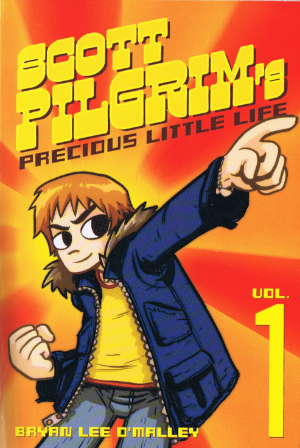Scott on Scott Pilgrim and the Best OEL Manga Evar!!!
I once heard that in marketing, the customer will become interested in a product after it has been recommended to them three times. A year ago, I had read a gushing review of the OEL manga series Scott Pilgrim in ANN’s weekly review section. A month later, the hosts of the video podcast The Totally Rad show had also given very positive impressions of the series. So it was almost too easy for Amazon to sell me a copy of the series when I was hit with it a third time in their “Recommended for you” section.
The title character of the series is an unemployed 23-year-old Canadian just off of a major break-up. After trying to date a shy high school girl, he meets a wild American girl, Ramona, who turns his boring life completely around. What follows next is six surreal volumes of comedy and ridiculous ninja action as Scott has to literally confront and battle every ex-boyfriend of Ramona in order to be with her.
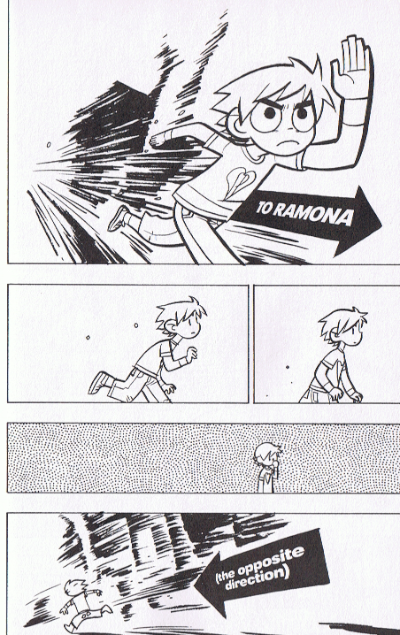
And because it is created by Canadian artist Brian Lee O’Malley, Scott Pilgrim is proof that a manga series created by a Westerner can speak to the Western audience in ways that Japanese comics can’t. It is one of the best comics I have ever read, and it is OEL at its finest.
Well, by now I’m sure that most of you are ready to send me an email saying, “Just how the hell can you call Scott Pilgrim an OEL manga?!?” Hisui of Reverse Thieves recently spent some time going over how much he felt the series shouldn’t be labeled as such. And when ANN’s Mikhail Koulikov asked O’Malley himself at the New York Comic Con last month, the artist seemed absolutely bewildered over the notion that his work could ever be considered “manga” in any way.
It most certainly looks like I’m in the wrong by calling Pilgrim an OEL series, but in fact, I’ve found that almost any mention of this acronym will spark protest from fans and professionals no matter what context it’s used in. So let me just take some time to explain my definition of OEL.
American manga fans can surely agree with me in saying that there is something very unique when it comes to comparing Japanese manga to domestic comics like Superman and X-men. But when comparing Japanese comics to Korean comics – often called “manwha” by fans and elitist jerks – I believe that you will find little distinction between the two besides page orientation and language. Because of their cultural similarities, I believe that Korean and Japanese comics should be grouped into the same category, and so I propose we break comics into either an “Asian style” or a “Western style” when describing them rather than saying words like manga or manwha.
So what’s the difference between the two styles? Well, Asian comics are generally drawn in black-and-white, emphasizes character designs with over-exaggerate facial features (big eyes, crazy hair), and contain a sparse amount of dialogue to allow the reader to quickly digest each volume. Western comics, on the other hand, are almost always in full color, places emphasis on costumes and clothing for character designing, and often contain a dense amount of dialogue in each word bubble. You don’t quickly digest Western comics, you keep them in plastic and collect them into a bin.
When a Western artist makes a comic in the Asian style rather than the Western style, I refer to it as an OEL (Original English Language) manga. I don’t know who originated the term, and admit that it’s probably not the best acronym to describe it, but I go with it for the sake of simplicity. I’ve also heard the phrase “global manga” used as to not limit the work to just English, but the problem comes from just using the word “manga.” Many fans believe that it is simply blasphemous to use the word manga to describe anything that did not originate from Japan.
But to me, a comic is just a comic and it’s silly to hang yourself up on some fan-derived jargon. If you really want to get “authentic” over vocabulary, then you would have to realize that the Japanese interchange their native word “manga” with the English word “comic” very often. They’re just synonyms to the Japanese. In fact, I think they might actually use the English word more often.
I prefer Asian style comics over Western style, but I don’t think the country of origination really makes that much of a difference. The only thing that changes with the nationality of the artist is the cultural elements presented in the story. Once again, Japan and Korea share very similar cultures. But when you see a Westerner create an OEL manga, you really start to see something that will appeal to the domestic market in a different way than an import would.
And the Scott Pilgrim series is the perfect example of this.
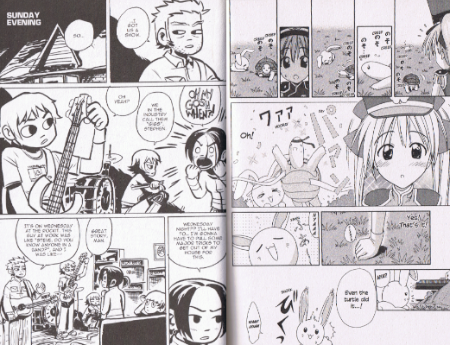
Scott Pilgrim (left) next to “real” Japanese manga (right)
With his black-and-white shading, characters with huge eyes, exaggerated facial expressions, and quick bouts of dialogue, O’Malley’s draws in the Asian style. However, he is most certainly not from Asia. Hell, he’s not even from America – he’s Canadian! But because of this, he is able to fill the comic with a very unique voice so ingrained with our domestic geek culture that is much more in tuned with his audience than foreign manga is for them.
O’Malley obviously grew up in the same 16-bit era of video gaming that many 20-somethings have grown up in. He frequently makes references to video games from the 80’s and 90’s. Some of them very blatant, and others that you kinda have to dig deep to remember. If it wasn’t for the fact that I had played the PSP remake of Parappa the Rapper the week before picking up the third volume, I probably would have never caught this:
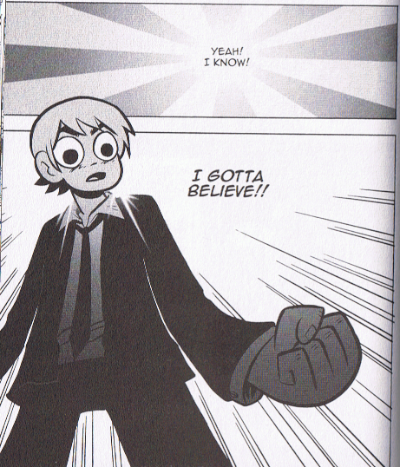
Can you get this kind of humor in Japanese manga? Well, whenever you get a series filled with pop-culture references such as Hayate the Combat Butler or Lucky Star, the biggest complaint from a Western audience is that you don’t understand most of the jokes. Even if you’re a hardcore otaku, how are you going to get Konata parodying a hair commercial from the 80’s? We didn’t grow up in Japan. That’s not the pop-culture we knew about during our impressionable years. But if you played a Sega Genesis and the Super Nintendo in the 90’s and never gave a damn about the Mega Drive and Super Famicom, then you understand the world that O’Malley created in his OEL series. You understand it completely.
But the biggest charm of O’Malley’s series is the dialogue. It’s frank, cynical, quirky, and absolutely hilarious. But that’s the way that young geeks talk. For such a ridiculous and fictional world, its characters speak incredibly realistic. It feels like the way I would talk with my buddies back in high school while we were goofing off at the local diner. You’re not going to get dialogue like that in Japanese manga because the Japanese don’t talk like us and you always lose something in translation between the languages.
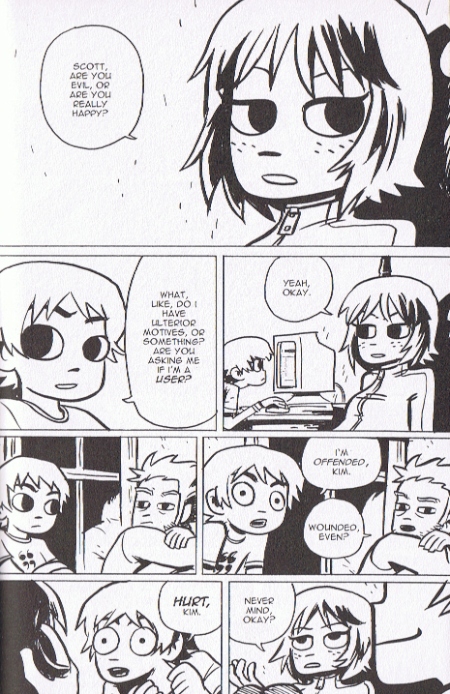
I can’t really say much about Scott Pilgrim except for the fact that it is awesome the same way that video games, manga, and ninjas are awesome. Don’t let the fact that it’s not Japanese throw you off, this was made by a Western geek for Western geeks to read.
So hopefully this is the third time that you’ve been recommended the Scott Pilgirm OEL series so that you’ll go out and pick up the first volume right away. But if not, at least you’re either a third to two-thirds of the way there. 😉
